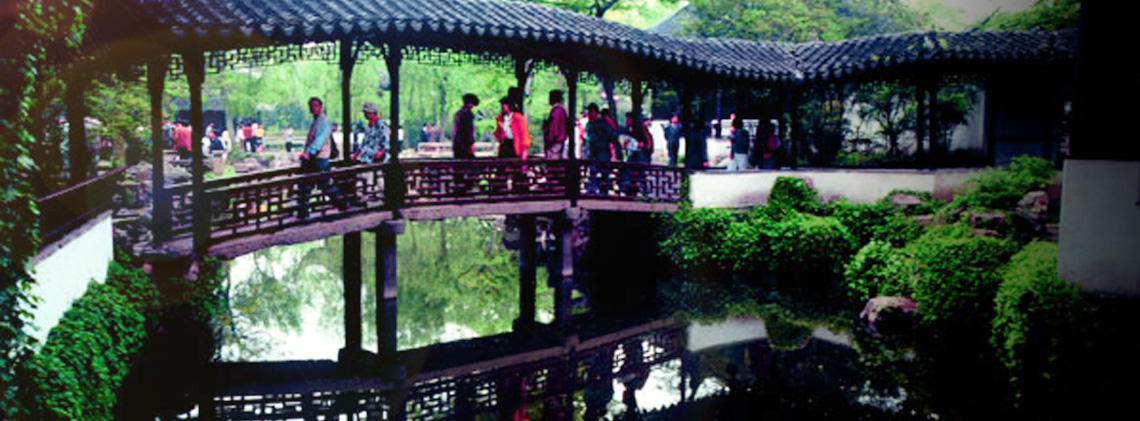
Historic City of Suzhou
Splendid
Chi Culture
Topic
Historic City of Suzhou
Suzhou, also known as Wu, Gusu, and Pingjiang at various times in history, is a major city on China’s eastern seaboard. It is located in southeastern of Jiangsu province, situated on the eastern shore of Taihu (Lake Tai). By virtue of its 2,500-year history, Suzhou ranks among China’s most renowned historic and cultural cities.
With a mild and moist climate, fertile soil, and numerous rivers and lakes facilitating irrigation and fishery, Suzhou has been a “land of fish and rice” over the centuries. Fishing and rice cultivation both appeared in Suzhou some millennia ago, and in the Tang (618–907) and Song (960–1279) dynasties Suzhou became China’s agricultural center. According to historical records, the annual output of grain in Suzhou and Huzhou (a neighboring city in modern Zhejiang province) during the Song dynasty exceeded 600 million kilograms; an amount sufficient to supply the nation’s eleven million households each with sixty kilograms of grain. As a contemporary folk saying went, “Crops that ripen in Suzhou and Huzhou are enough to feed the whole world.”
Handicraft industries developed early in Suzhou, whose fine products included the “Wu sword” during the Spring and Autumn period (770–476 BCE), sea vessels during the Three States period (220–280), and silk brocade and high-quality writing paper during the Northern Song dynasty (960–1127). Suzhou’s embroidery, fans, and jade carvings have long been in great demand both in China and abroad. The city was a flourishing commercial port from as early as the Tang and Song period. The popular saying “Up above there is heaven; down below there are Suzhou and Hangzhou” encapsulates the thriving economy and abundant life of Suzhou and Hangzhou during that period.
As the most famous water town in China, its canals and bridges make up the veins of the city; this has earned Suzhou the nickname “Venice of the East.” The Tang dynasty poet Du Xunhe (846–904) once said of the city “When you come to Suzhou, you will see, / Each house resting along the rivers, / Vacant land is scarce in this ancient capital, / There are many small bridges over the water allies.” Although many former canals in Suzhou have been filled in and leveled, the old water-town landscape is still well preserved along Shantang Street and in the protected district of Pingjiang.
Suzhou is also a city permeated with culture. Since ancient times, the people of Suzhou have placed a high value on culture and education; the city saw the rise of numerous scholars and cultural elites. Yan Yan (506–443 BCE) was a follower of Confucius (551–479 BCE) during the Spring and Autumn period. After returning to his hometown of Wu, he devoted himself to the promotion of Confucian ideas, “acquainting every household in the region of Wu with poetry and prose, etiquette, and music.” During the Ming (1368–1644) and Qing (1644–1911) dynasties, the emergence of numerous gifted scholars earned Suzhou the nickname “Home to the Principal Graduates (i.e., those who achieved first place on the list of the imperial examination candidates).”
In addition to Confucian scholars, Suzhou is also the birthplace of many renowned poets, authors, and painters. Shen Zhou (1427–1509), Wen Zhengming (1470–1559), Tang Yin (1470–1524), and Qiu Ying (ca. 1495–1552) were painters and collectively they were known variously as the “Four Masters of the Ming dynasty,” or the “Four Masters of Wu School Painting,” for all of them were based in Suzhou. The influence of Wu school painting on the Ming and Qing painting style spanned 400 years.
Suzhou literati played an important role in the theatrical world during the late Yuan and the early Ming dynasties (ca. the fourteenth century). Scholars at this time became increasingly active in the field of traditional opera giving rise to the influential Wu school of opera. The art of traditional opera was not only favored by men of letters, but it was also popular among ordinary people. As a poem puts it, “[in Suzhou] singing is common in every household; even a three-year-old child knows Southern drama.”
The most distinctive sights of Suzhou can be found in its many classical gardens, for which it is world famous. According to historical records, there were over 170 gardens in Suzhou by the end of the Qing dynasty, more than seventy of which have been well preserved to this day. Classical gardens such as the Humble Administrator’s Garden (Zhuozheng yuan), Lingering Garden (Liu yuan), the Master-of-Nets Garden (Wangshi yuan), and the Lion’s Grove Garden (Shizi lin) have been included in the World Heritage List by the United Nations Educational, Scientific and Cultural Organization. Among the various gardens, the private ones are the most exquisite. Suzhou gardens are characterized by harmony between humans and nature, which “though done by human hands seem to be made by nature.”
The Humble Administrator’s Garden was built by Wang Xianchen during the Zhengde reign (1506–1521) of the Ming emperor Wuzong. Wang was a courtier who had been unfairly accused of wrong doing and dismissed from his post. He returned home to Suzhou and said that for someone as inept as he was, watering flowers and growing vegetables were the same as government service. This is the reason he named it as he did.
Today’s Suzhou, an attractive tourist city with leading hi-tech industrial parks, combines in harmony the old and the new, the traditional and the modern.



